Organization and Behavior | Procter and Gamble UK
VerifiedAdded on 2022/07/28
|12
|4924
|461
AI Summary
Contribute Materials
Your contribution can guide someone’s learning journey. Share your
documents today.
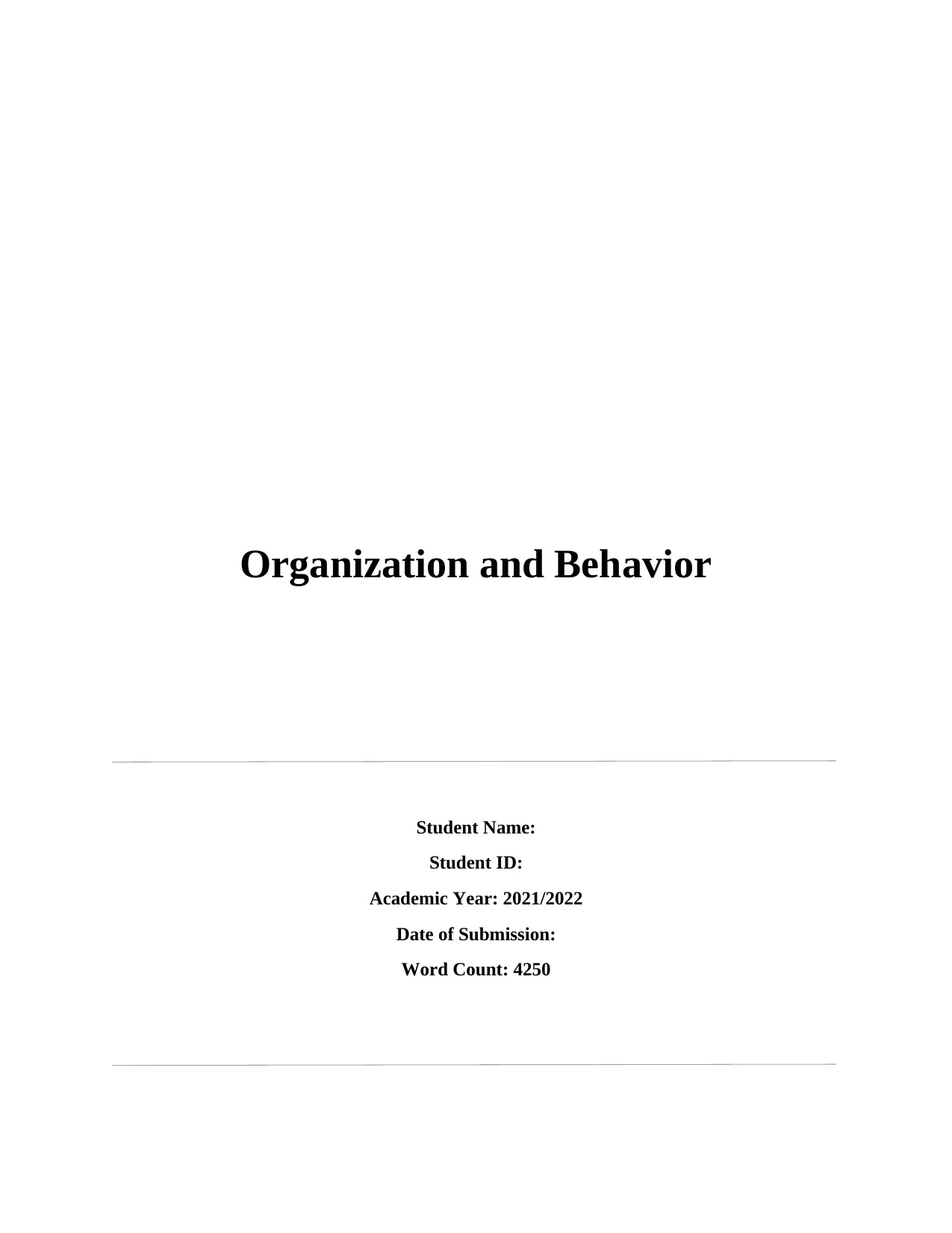
Organization and Behavior
Student Name:
Student ID:
Academic Year: 2021/2022
Date of Submission:
Word Count: 4250
Student Name:
Student ID:
Academic Year: 2021/2022
Date of Submission:
Word Count: 4250
Secure Best Marks with AI Grader
Need help grading? Try our AI Grader for instant feedback on your assignments.
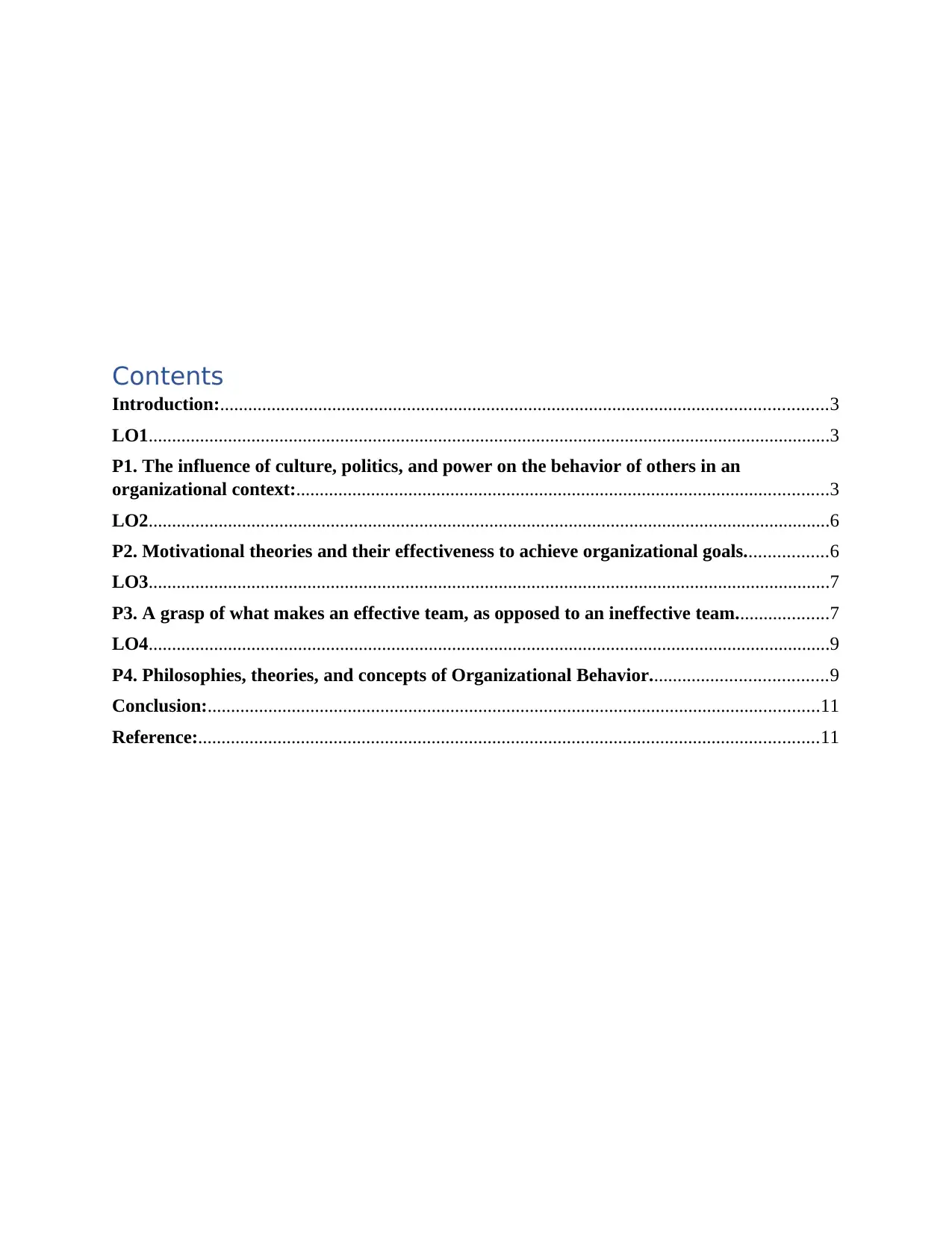
Contents
Introduction:..................................................................................................................................3
LO1..................................................................................................................................................3
P1. The influence of culture, politics, and power on the behavior of others in an
organizational context:..................................................................................................................3
LO2..................................................................................................................................................6
P2. Motivational theories and their effectiveness to achieve organizational goals..................6
LO3..................................................................................................................................................7
P3. A grasp of what makes an effective team, as opposed to an ineffective team....................7
LO4..................................................................................................................................................9
P4. Philosophies, theories, and concepts of Organizational Behavior......................................9
Conclusion:...................................................................................................................................11
Reference:.....................................................................................................................................11
Introduction:..................................................................................................................................3
LO1..................................................................................................................................................3
P1. The influence of culture, politics, and power on the behavior of others in an
organizational context:..................................................................................................................3
LO2..................................................................................................................................................6
P2. Motivational theories and their effectiveness to achieve organizational goals..................6
LO3..................................................................................................................................................7
P3. A grasp of what makes an effective team, as opposed to an ineffective team....................7
LO4..................................................................................................................................................9
P4. Philosophies, theories, and concepts of Organizational Behavior......................................9
Conclusion:...................................................................................................................................11
Reference:.....................................................................................................................................11
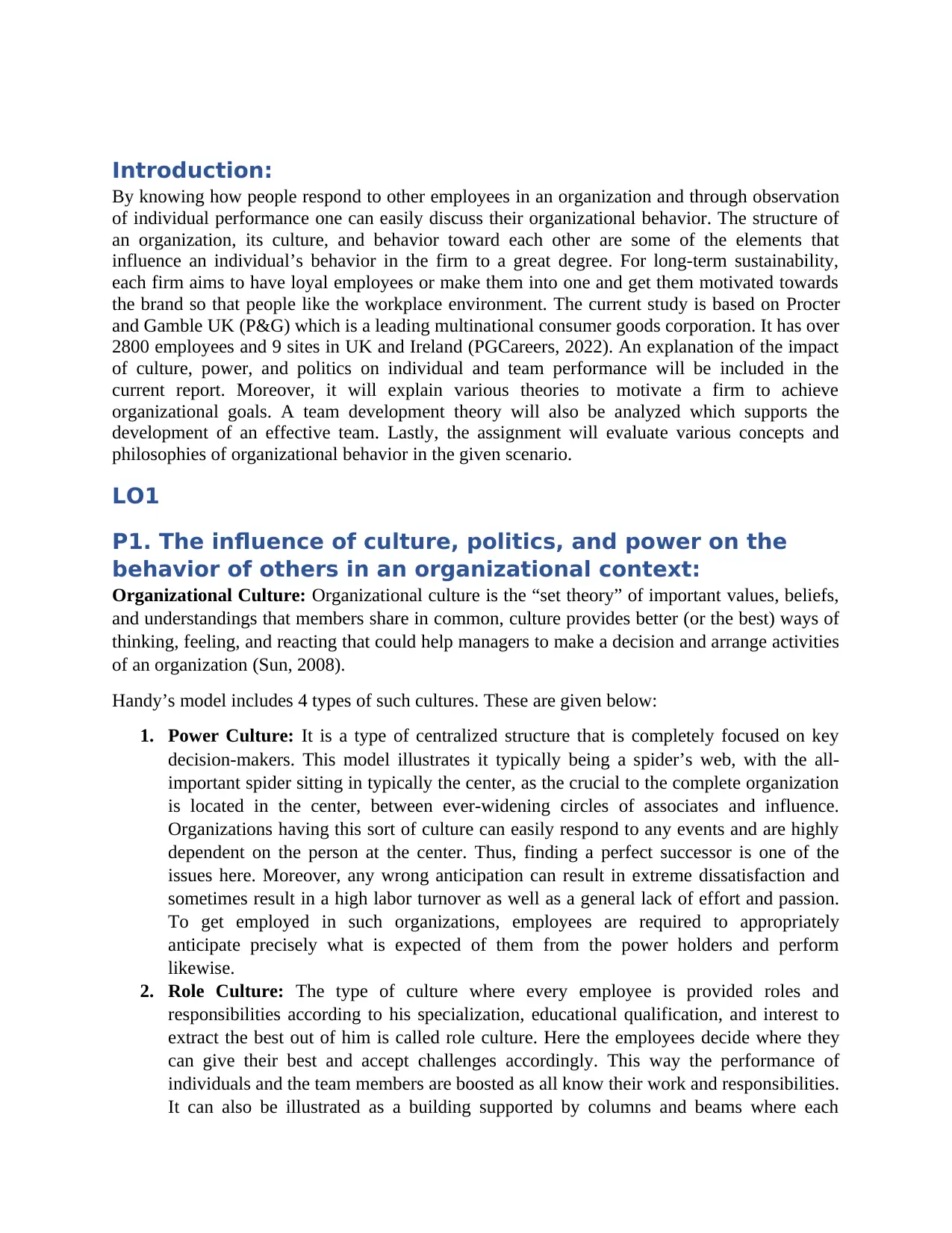
Introduction:
By knowing how people respond to other employees in an organization and through observation
of individual performance one can easily discuss their organizational behavior. The structure of
an organization, its culture, and behavior toward each other are some of the elements that
influence an individual’s behavior in the firm to a great degree. For long-term sustainability,
each firm aims to have loyal employees or make them into one and get them motivated towards
the brand so that people like the workplace environment. The current study is based on Procter
and Gamble UK (P&G) which is a leading multinational consumer goods corporation. It has over
2800 employees and 9 sites in UK and Ireland (PGCareers, 2022). An explanation of the impact
of culture, power, and politics on individual and team performance will be included in the
current report. Moreover, it will explain various theories to motivate a firm to achieve
organizational goals. A team development theory will also be analyzed which supports the
development of an effective team. Lastly, the assignment will evaluate various concepts and
philosophies of organizational behavior in the given scenario.
LO1
P1. The influence of culture, politics, and power on the
behavior of others in an organizational context:
Organizational Culture: Organizational culture is the “set theory” of important values, beliefs,
and understandings that members share in common, culture provides better (or the best) ways of
thinking, feeling, and reacting that could help managers to make a decision and arrange activities
of an organization (Sun, 2008).
Handy’s model includes 4 types of such cultures. These are given below:
1. Power Culture: It is a type of centralized structure that is completely focused on key
decision-makers. This model illustrates it typically being a spider’s web, with the all-
important spider sitting in typically the center, as the crucial to the complete organization
is located in the center, between ever-widening circles of associates and influence.
Organizations having this sort of culture can easily respond to any events and are highly
dependent on the person at the center. Thus, finding a perfect successor is one of the
issues here. Moreover, any wrong anticipation can result in extreme dissatisfaction and
sometimes result in a high labor turnover as well as a general lack of effort and passion.
To get employed in such organizations, employees are required to appropriately
anticipate precisely what is expected of them from the power holders and perform
likewise.
2. Role Culture: The type of culture where every employee is provided roles and
responsibilities according to his specialization, educational qualification, and interest to
extract the best out of him is called role culture. Here the employees decide where they
can give their best and accept challenges accordingly. This way the performance of
individuals and the team members are boosted as all know their work and responsibilities.
It can also be illustrated as a building supported by columns and beams where each
By knowing how people respond to other employees in an organization and through observation
of individual performance one can easily discuss their organizational behavior. The structure of
an organization, its culture, and behavior toward each other are some of the elements that
influence an individual’s behavior in the firm to a great degree. For long-term sustainability,
each firm aims to have loyal employees or make them into one and get them motivated towards
the brand so that people like the workplace environment. The current study is based on Procter
and Gamble UK (P&G) which is a leading multinational consumer goods corporation. It has over
2800 employees and 9 sites in UK and Ireland (PGCareers, 2022). An explanation of the impact
of culture, power, and politics on individual and team performance will be included in the
current report. Moreover, it will explain various theories to motivate a firm to achieve
organizational goals. A team development theory will also be analyzed which supports the
development of an effective team. Lastly, the assignment will evaluate various concepts and
philosophies of organizational behavior in the given scenario.
LO1
P1. The influence of culture, politics, and power on the
behavior of others in an organizational context:
Organizational Culture: Organizational culture is the “set theory” of important values, beliefs,
and understandings that members share in common, culture provides better (or the best) ways of
thinking, feeling, and reacting that could help managers to make a decision and arrange activities
of an organization (Sun, 2008).
Handy’s model includes 4 types of such cultures. These are given below:
1. Power Culture: It is a type of centralized structure that is completely focused on key
decision-makers. This model illustrates it typically being a spider’s web, with the all-
important spider sitting in typically the center, as the crucial to the complete organization
is located in the center, between ever-widening circles of associates and influence.
Organizations having this sort of culture can easily respond to any events and are highly
dependent on the person at the center. Thus, finding a perfect successor is one of the
issues here. Moreover, any wrong anticipation can result in extreme dissatisfaction and
sometimes result in a high labor turnover as well as a general lack of effort and passion.
To get employed in such organizations, employees are required to appropriately
anticipate precisely what is expected of them from the power holders and perform
likewise.
2. Role Culture: The type of culture where every employee is provided roles and
responsibilities according to his specialization, educational qualification, and interest to
extract the best out of him is called role culture. Here the employees decide where they
can give their best and accept challenges accordingly. This way the performance of
individuals and the team members are boosted as all know their work and responsibilities.
It can also be illustrated as a building supported by columns and beams where each
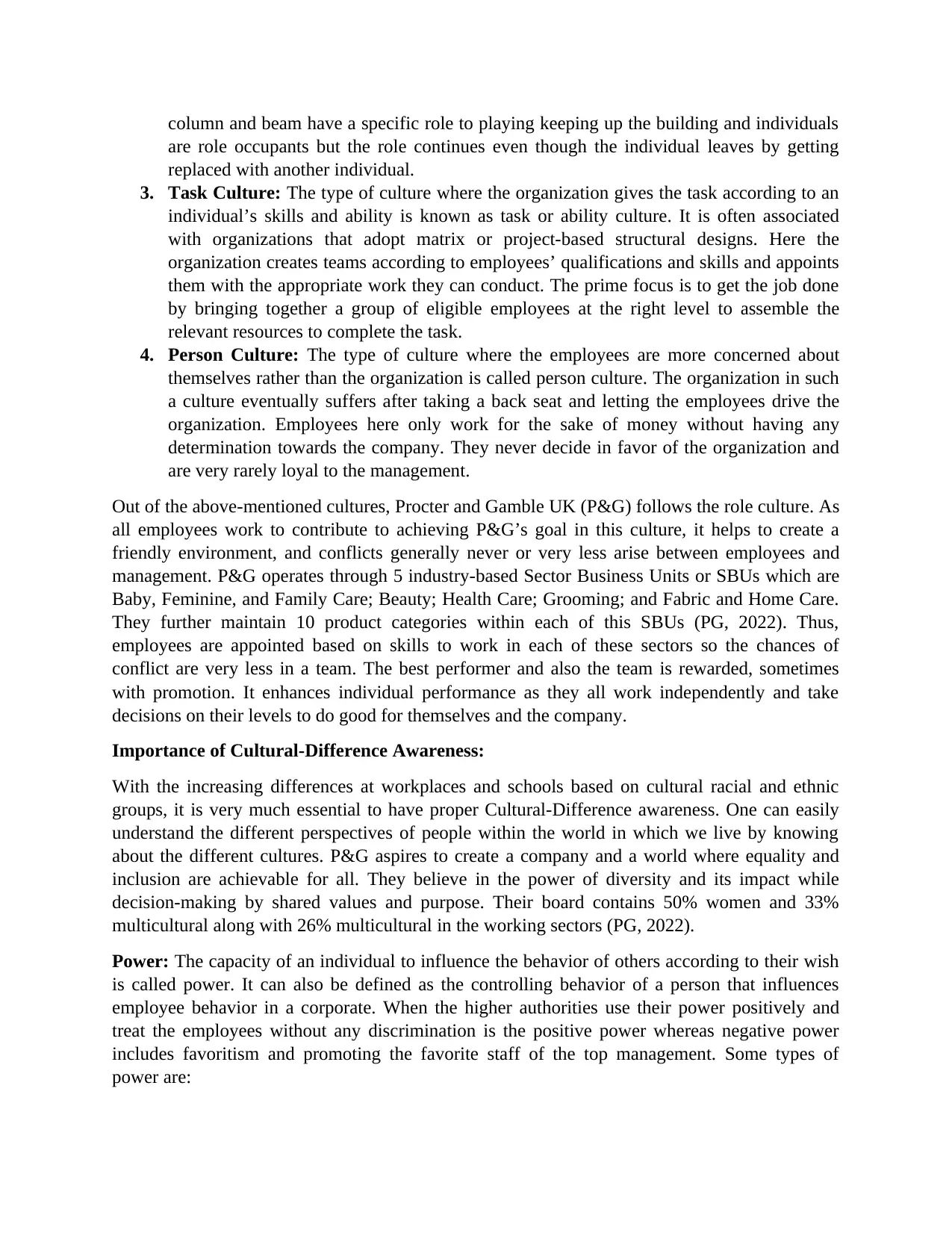
column and beam have a specific role to playing keeping up the building and individuals
are role occupants but the role continues even though the individual leaves by getting
replaced with another individual.
3. Task Culture: The type of culture where the organization gives the task according to an
individual’s skills and ability is known as task or ability culture. It is often associated
with organizations that adopt matrix or project-based structural designs. Here the
organization creates teams according to employees’ qualifications and skills and appoints
them with the appropriate work they can conduct. The prime focus is to get the job done
by bringing together a group of eligible employees at the right level to assemble the
relevant resources to complete the task.
4. Person Culture: The type of culture where the employees are more concerned about
themselves rather than the organization is called person culture. The organization in such
a culture eventually suffers after taking a back seat and letting the employees drive the
organization. Employees here only work for the sake of money without having any
determination towards the company. They never decide in favor of the organization and
are very rarely loyal to the management.
Out of the above-mentioned cultures, Procter and Gamble UK (P&G) follows the role culture. As
all employees work to contribute to achieving P&G’s goal in this culture, it helps to create a
friendly environment, and conflicts generally never or very less arise between employees and
management. P&G operates through 5 industry-based Sector Business Units or SBUs which are
Baby, Feminine, and Family Care; Beauty; Health Care; Grooming; and Fabric and Home Care.
They further maintain 10 product categories within each of this SBUs (PG, 2022). Thus,
employees are appointed based on skills to work in each of these sectors so the chances of
conflict are very less in a team. The best performer and also the team is rewarded, sometimes
with promotion. It enhances individual performance as they all work independently and take
decisions on their levels to do good for themselves and the company.
Importance of Cultural-Difference Awareness:
With the increasing differences at workplaces and schools based on cultural racial and ethnic
groups, it is very much essential to have proper Cultural-Difference awareness. One can easily
understand the different perspectives of people within the world in which we live by knowing
about the different cultures. P&G aspires to create a company and a world where equality and
inclusion are achievable for all. They believe in the power of diversity and its impact while
decision-making by shared values and purpose. Their board contains 50% women and 33%
multicultural along with 26% multicultural in the working sectors (PG, 2022).
Power: The capacity of an individual to influence the behavior of others according to their wish
is called power. It can also be defined as the controlling behavior of a person that influences
employee behavior in a corporate. When the higher authorities use their power positively and
treat the employees without any discrimination is the positive power whereas negative power
includes favoritism and promoting the favorite staff of the top management. Some types of
power are:
are role occupants but the role continues even though the individual leaves by getting
replaced with another individual.
3. Task Culture: The type of culture where the organization gives the task according to an
individual’s skills and ability is known as task or ability culture. It is often associated
with organizations that adopt matrix or project-based structural designs. Here the
organization creates teams according to employees’ qualifications and skills and appoints
them with the appropriate work they can conduct. The prime focus is to get the job done
by bringing together a group of eligible employees at the right level to assemble the
relevant resources to complete the task.
4. Person Culture: The type of culture where the employees are more concerned about
themselves rather than the organization is called person culture. The organization in such
a culture eventually suffers after taking a back seat and letting the employees drive the
organization. Employees here only work for the sake of money without having any
determination towards the company. They never decide in favor of the organization and
are very rarely loyal to the management.
Out of the above-mentioned cultures, Procter and Gamble UK (P&G) follows the role culture. As
all employees work to contribute to achieving P&G’s goal in this culture, it helps to create a
friendly environment, and conflicts generally never or very less arise between employees and
management. P&G operates through 5 industry-based Sector Business Units or SBUs which are
Baby, Feminine, and Family Care; Beauty; Health Care; Grooming; and Fabric and Home Care.
They further maintain 10 product categories within each of this SBUs (PG, 2022). Thus,
employees are appointed based on skills to work in each of these sectors so the chances of
conflict are very less in a team. The best performer and also the team is rewarded, sometimes
with promotion. It enhances individual performance as they all work independently and take
decisions on their levels to do good for themselves and the company.
Importance of Cultural-Difference Awareness:
With the increasing differences at workplaces and schools based on cultural racial and ethnic
groups, it is very much essential to have proper Cultural-Difference awareness. One can easily
understand the different perspectives of people within the world in which we live by knowing
about the different cultures. P&G aspires to create a company and a world where equality and
inclusion are achievable for all. They believe in the power of diversity and its impact while
decision-making by shared values and purpose. Their board contains 50% women and 33%
multicultural along with 26% multicultural in the working sectors (PG, 2022).
Power: The capacity of an individual to influence the behavior of others according to their wish
is called power. It can also be defined as the controlling behavior of a person that influences
employee behavior in a corporate. When the higher authorities use their power positively and
treat the employees without any discrimination is the positive power whereas negative power
includes favoritism and promoting the favorite staff of the top management. Some types of
power are:
Secure Best Marks with AI Grader
Need help grading? Try our AI Grader for instant feedback on your assignments.
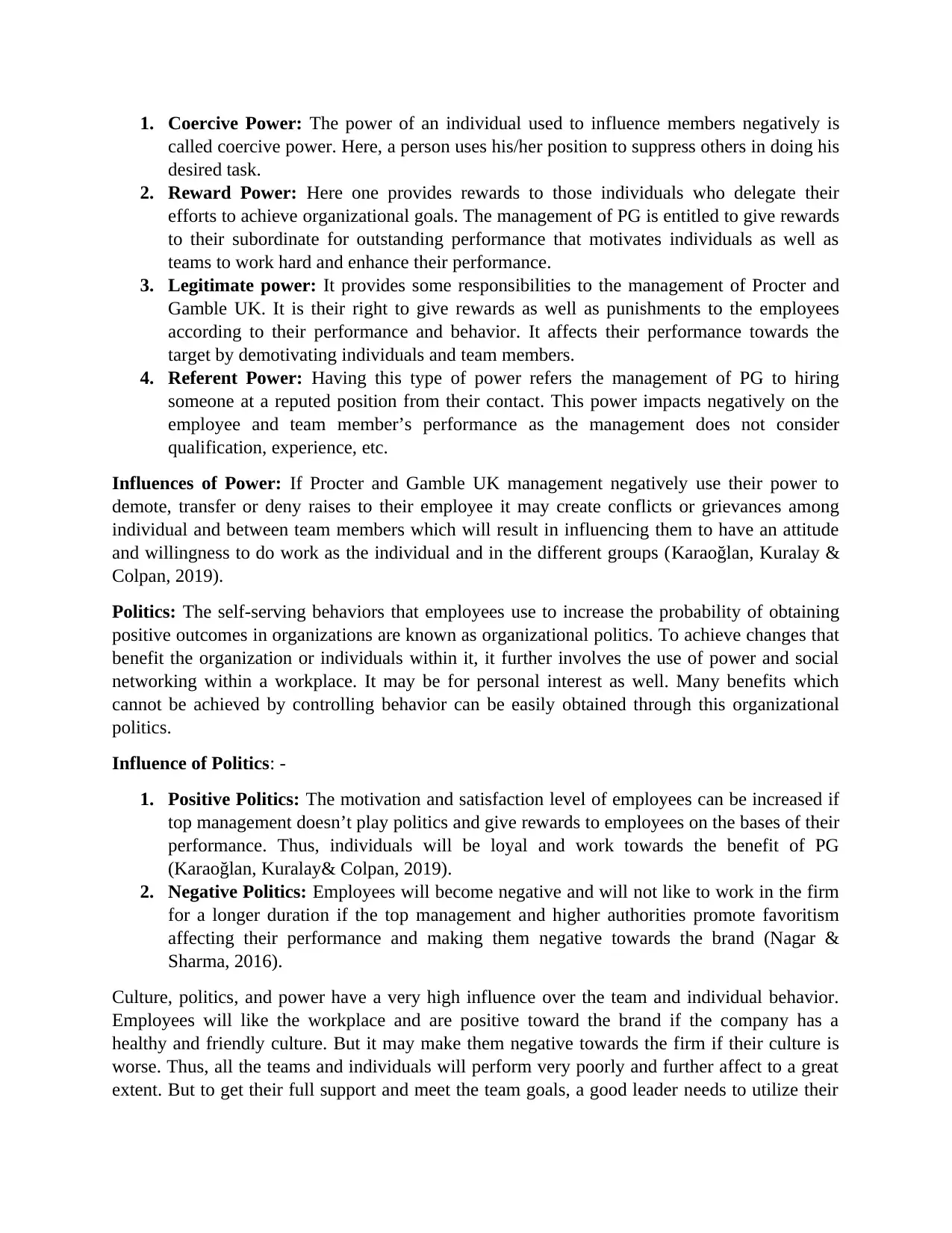
1. Coercive Power: The power of an individual used to influence members negatively is
called coercive power. Here, a person uses his/her position to suppress others in doing his
desired task.
2. Reward Power: Here one provides rewards to those individuals who delegate their
efforts to achieve organizational goals. The management of PG is entitled to give rewards
to their subordinate for outstanding performance that motivates individuals as well as
teams to work hard and enhance their performance.
3. Legitimate power: It provides some responsibilities to the management of Procter and
Gamble UK. It is their right to give rewards as well as punishments to the employees
according to their performance and behavior. It affects their performance towards the
target by demotivating individuals and team members.
4. Referent Power: Having this type of power refers the management of PG to hiring
someone at a reputed position from their contact. This power impacts negatively on the
employee and team member’s performance as the management does not consider
qualification, experience, etc.
Influences of Power: If Procter and Gamble UK management negatively use their power to
demote, transfer or deny raises to their employee it may create conflicts or grievances among
individual and between team members which will result in influencing them to have an attitude
and willingness to do work as the individual and in the different groups (Karaoğlan, Kuralay &
Colpan, 2019).
Politics: The self-serving behaviors that employees use to increase the probability of obtaining
positive outcomes in organizations are known as organizational politics. To achieve changes that
benefit the organization or individuals within it, it further involves the use of power and social
networking within a workplace. It may be for personal interest as well. Many benefits which
cannot be achieved by controlling behavior can be easily obtained through this organizational
politics.
Influence of Politics: -
1. Positive Politics: The motivation and satisfaction level of employees can be increased if
top management doesn’t play politics and give rewards to employees on the bases of their
performance. Thus, individuals will be loyal and work towards the benefit of PG
(Karaoğlan, Kuralay& Colpan, 2019).
2. Negative Politics: Employees will become negative and will not like to work in the firm
for a longer duration if the top management and higher authorities promote favoritism
affecting their performance and making them negative towards the brand (Nagar &
Sharma, 2016).
Culture, politics, and power have a very high influence over the team and individual behavior.
Employees will like the workplace and are positive toward the brand if the company has a
healthy and friendly culture. But it may make them negative towards the firm if their culture is
worse. Thus, all the teams and individuals will perform very poorly and further affect to a great
extent. But to get their full support and meet the team goals, a good leader needs to utilize their
called coercive power. Here, a person uses his/her position to suppress others in doing his
desired task.
2. Reward Power: Here one provides rewards to those individuals who delegate their
efforts to achieve organizational goals. The management of PG is entitled to give rewards
to their subordinate for outstanding performance that motivates individuals as well as
teams to work hard and enhance their performance.
3. Legitimate power: It provides some responsibilities to the management of Procter and
Gamble UK. It is their right to give rewards as well as punishments to the employees
according to their performance and behavior. It affects their performance towards the
target by demotivating individuals and team members.
4. Referent Power: Having this type of power refers the management of PG to hiring
someone at a reputed position from their contact. This power impacts negatively on the
employee and team member’s performance as the management does not consider
qualification, experience, etc.
Influences of Power: If Procter and Gamble UK management negatively use their power to
demote, transfer or deny raises to their employee it may create conflicts or grievances among
individual and between team members which will result in influencing them to have an attitude
and willingness to do work as the individual and in the different groups (Karaoğlan, Kuralay &
Colpan, 2019).
Politics: The self-serving behaviors that employees use to increase the probability of obtaining
positive outcomes in organizations are known as organizational politics. To achieve changes that
benefit the organization or individuals within it, it further involves the use of power and social
networking within a workplace. It may be for personal interest as well. Many benefits which
cannot be achieved by controlling behavior can be easily obtained through this organizational
politics.
Influence of Politics: -
1. Positive Politics: The motivation and satisfaction level of employees can be increased if
top management doesn’t play politics and give rewards to employees on the bases of their
performance. Thus, individuals will be loyal and work towards the benefit of PG
(Karaoğlan, Kuralay& Colpan, 2019).
2. Negative Politics: Employees will become negative and will not like to work in the firm
for a longer duration if the top management and higher authorities promote favoritism
affecting their performance and making them negative towards the brand (Nagar &
Sharma, 2016).
Culture, politics, and power have a very high influence over the team and individual behavior.
Employees will like the workplace and are positive toward the brand if the company has a
healthy and friendly culture. But it may make them negative towards the firm if their culture is
worse. Thus, all the teams and individuals will perform very poorly and further affect to a great
extent. But to get their full support and meet the team goals, a good leader needs to utilize their
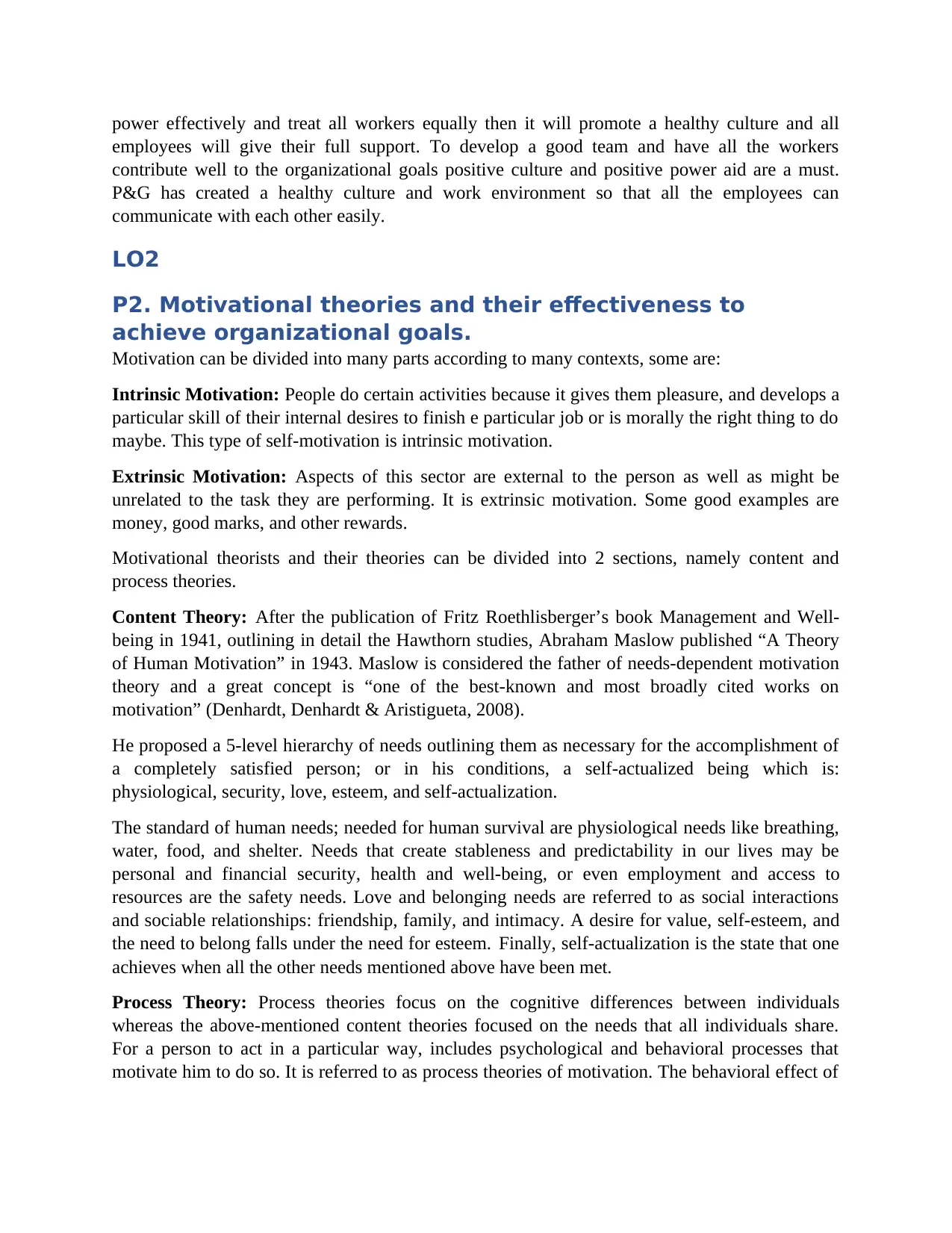
power effectively and treat all workers equally then it will promote a healthy culture and all
employees will give their full support. To develop a good team and have all the workers
contribute well to the organizational goals positive culture and positive power aid are a must.
P&G has created a healthy culture and work environment so that all the employees can
communicate with each other easily.
LO2
P2. Motivational theories and their effectiveness to
achieve organizational goals.
Motivation can be divided into many parts according to many contexts, some are:
Intrinsic Motivation: People do certain activities because it gives them pleasure, and develops a
particular skill of their internal desires to finish e particular job or is morally the right thing to do
maybe. This type of self-motivation is intrinsic motivation.
Extrinsic Motivation: Aspects of this sector are external to the person as well as might be
unrelated to the task they are performing. It is extrinsic motivation. Some good examples are
money, good marks, and other rewards.
Motivational theorists and their theories can be divided into 2 sections, namely content and
process theories.
Content Theory: After the publication of Fritz Roethlisberger’s book Management and Well-
being in 1941, outlining in detail the Hawthorn studies, Abraham Maslow published “A Theory
of Human Motivation” in 1943. Maslow is considered the father of needs-dependent motivation
theory and a great concept is “one of the best-known and most broadly cited works on
motivation” (Denhardt, Denhardt & Aristigueta, 2008).
He proposed a 5-level hierarchy of needs outlining them as necessary for the accomplishment of
a completely satisfied person; or in his conditions, a self-actualized being which is:
physiological, security, love, esteem, and self-actualization.
The standard of human needs; needed for human survival are physiological needs like breathing,
water, food, and shelter. Needs that create stableness and predictability in our lives may be
personal and financial security, health and well-being, or even employment and access to
resources are the safety needs. Love and belonging needs are referred to as social interactions
and sociable relationships: friendship, family, and intimacy. A desire for value, self-esteem, and
the need to belong falls under the need for esteem. Finally, self-actualization is the state that one
achieves when all the other needs mentioned above have been met.
Process Theory: Process theories focus on the cognitive differences between individuals
whereas the above-mentioned content theories focused on the needs that all individuals share.
For a person to act in a particular way, includes psychological and behavioral processes that
motivate him to do so. It is referred to as process theories of motivation. The behavioral effect of
employees will give their full support. To develop a good team and have all the workers
contribute well to the organizational goals positive culture and positive power aid are a must.
P&G has created a healthy culture and work environment so that all the employees can
communicate with each other easily.
LO2
P2. Motivational theories and their effectiveness to
achieve organizational goals.
Motivation can be divided into many parts according to many contexts, some are:
Intrinsic Motivation: People do certain activities because it gives them pleasure, and develops a
particular skill of their internal desires to finish e particular job or is morally the right thing to do
maybe. This type of self-motivation is intrinsic motivation.
Extrinsic Motivation: Aspects of this sector are external to the person as well as might be
unrelated to the task they are performing. It is extrinsic motivation. Some good examples are
money, good marks, and other rewards.
Motivational theorists and their theories can be divided into 2 sections, namely content and
process theories.
Content Theory: After the publication of Fritz Roethlisberger’s book Management and Well-
being in 1941, outlining in detail the Hawthorn studies, Abraham Maslow published “A Theory
of Human Motivation” in 1943. Maslow is considered the father of needs-dependent motivation
theory and a great concept is “one of the best-known and most broadly cited works on
motivation” (Denhardt, Denhardt & Aristigueta, 2008).
He proposed a 5-level hierarchy of needs outlining them as necessary for the accomplishment of
a completely satisfied person; or in his conditions, a self-actualized being which is:
physiological, security, love, esteem, and self-actualization.
The standard of human needs; needed for human survival are physiological needs like breathing,
water, food, and shelter. Needs that create stableness and predictability in our lives may be
personal and financial security, health and well-being, or even employment and access to
resources are the safety needs. Love and belonging needs are referred to as social interactions
and sociable relationships: friendship, family, and intimacy. A desire for value, self-esteem, and
the need to belong falls under the need for esteem. Finally, self-actualization is the state that one
achieves when all the other needs mentioned above have been met.
Process Theory: Process theories focus on the cognitive differences between individuals
whereas the above-mentioned content theories focused on the needs that all individuals share.
For a person to act in a particular way, includes psychological and behavioral processes that
motivate him to do so. It is referred to as process theories of motivation. The behavioral effect of
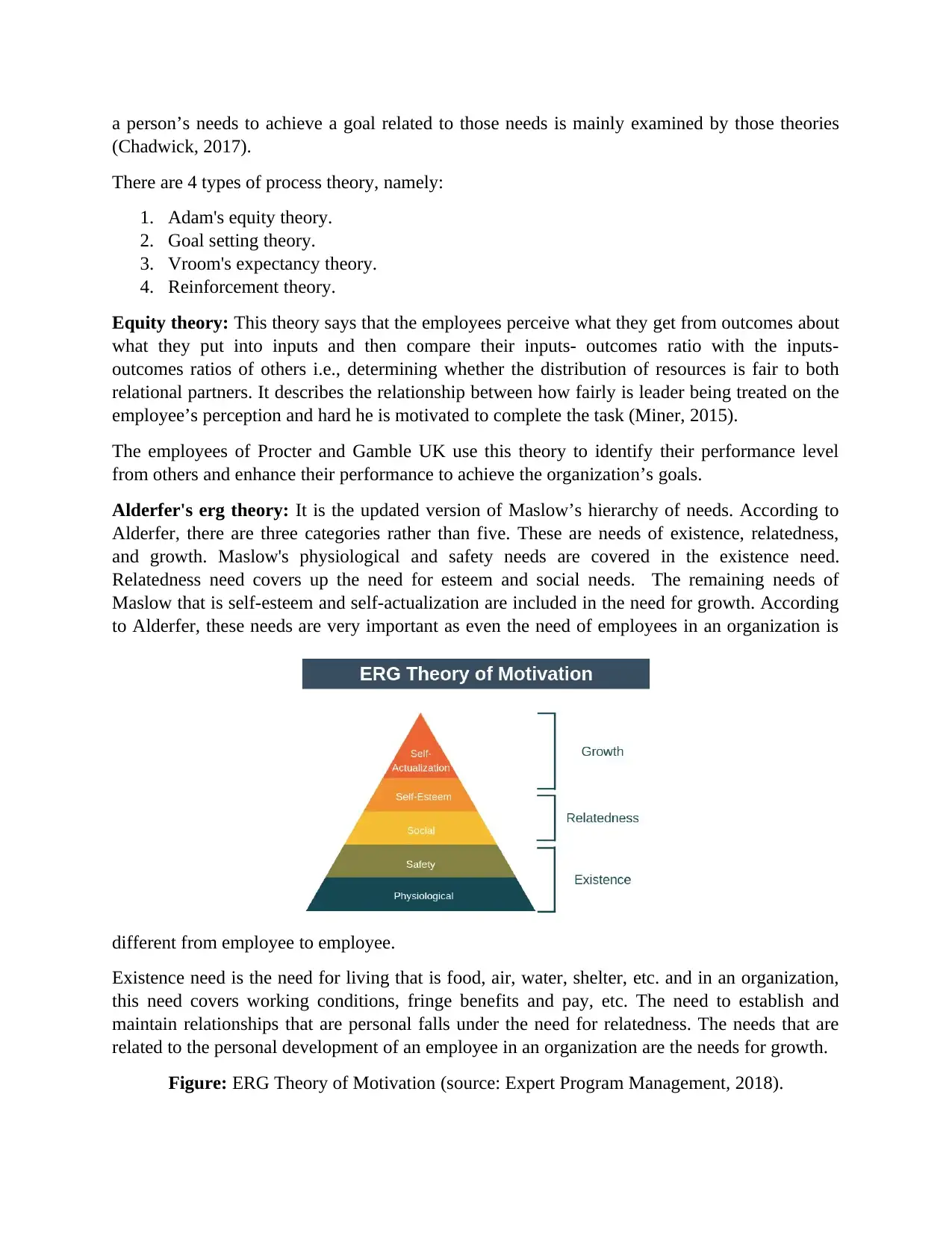
a person’s needs to achieve a goal related to those needs is mainly examined by those theories
(Chadwick, 2017).
There are 4 types of process theory, namely:
1. Adam's equity theory.
2. Goal setting theory.
3. Vroom's expectancy theory.
4. Reinforcement theory.
Equity theory: This theory says that the employees perceive what they get from outcomes about
what they put into inputs and then compare their inputs- outcomes ratio with the inputs-
outcomes ratios of others i.e., determining whether the distribution of resources is fair to both
relational partners. It describes the relationship between how fairly is leader being treated on the
employee’s perception and hard he is motivated to complete the task (Miner, 2015).
The employees of Procter and Gamble UK use this theory to identify their performance level
from others and enhance their performance to achieve the organization’s goals.
Alderfer's erg theory: It is the updated version of Maslow’s hierarchy of needs. According to
Alderfer, there are three categories rather than five. These are needs of existence, relatedness,
and growth. Maslow's physiological and safety needs are covered in the existence need.
Relatedness need covers up the need for esteem and social needs. The remaining needs of
Maslow that is self-esteem and self-actualization are included in the need for growth. According
to Alderfer, these needs are very important as even the need of employees in an organization is
different from employee to employee.
Existence need is the need for living that is food, air, water, shelter, etc. and in an organization,
this need covers working conditions, fringe benefits and pay, etc. The need to establish and
maintain relationships that are personal falls under the need for relatedness. The needs that are
related to the personal development of an employee in an organization are the needs for growth.
Figure: ERG Theory of Motivation (source: Expert Program Management, 2018).
(Chadwick, 2017).
There are 4 types of process theory, namely:
1. Adam's equity theory.
2. Goal setting theory.
3. Vroom's expectancy theory.
4. Reinforcement theory.
Equity theory: This theory says that the employees perceive what they get from outcomes about
what they put into inputs and then compare their inputs- outcomes ratio with the inputs-
outcomes ratios of others i.e., determining whether the distribution of resources is fair to both
relational partners. It describes the relationship between how fairly is leader being treated on the
employee’s perception and hard he is motivated to complete the task (Miner, 2015).
The employees of Procter and Gamble UK use this theory to identify their performance level
from others and enhance their performance to achieve the organization’s goals.
Alderfer's erg theory: It is the updated version of Maslow’s hierarchy of needs. According to
Alderfer, there are three categories rather than five. These are needs of existence, relatedness,
and growth. Maslow's physiological and safety needs are covered in the existence need.
Relatedness need covers up the need for esteem and social needs. The remaining needs of
Maslow that is self-esteem and self-actualization are included in the need for growth. According
to Alderfer, these needs are very important as even the need of employees in an organization is
different from employee to employee.
Existence need is the need for living that is food, air, water, shelter, etc. and in an organization,
this need covers working conditions, fringe benefits and pay, etc. The need to establish and
maintain relationships that are personal falls under the need for relatedness. The needs that are
related to the personal development of an employee in an organization are the needs for growth.
Figure: ERG Theory of Motivation (source: Expert Program Management, 2018).
Paraphrase This Document
Need a fresh take? Get an instant paraphrase of this document with our AI Paraphraser
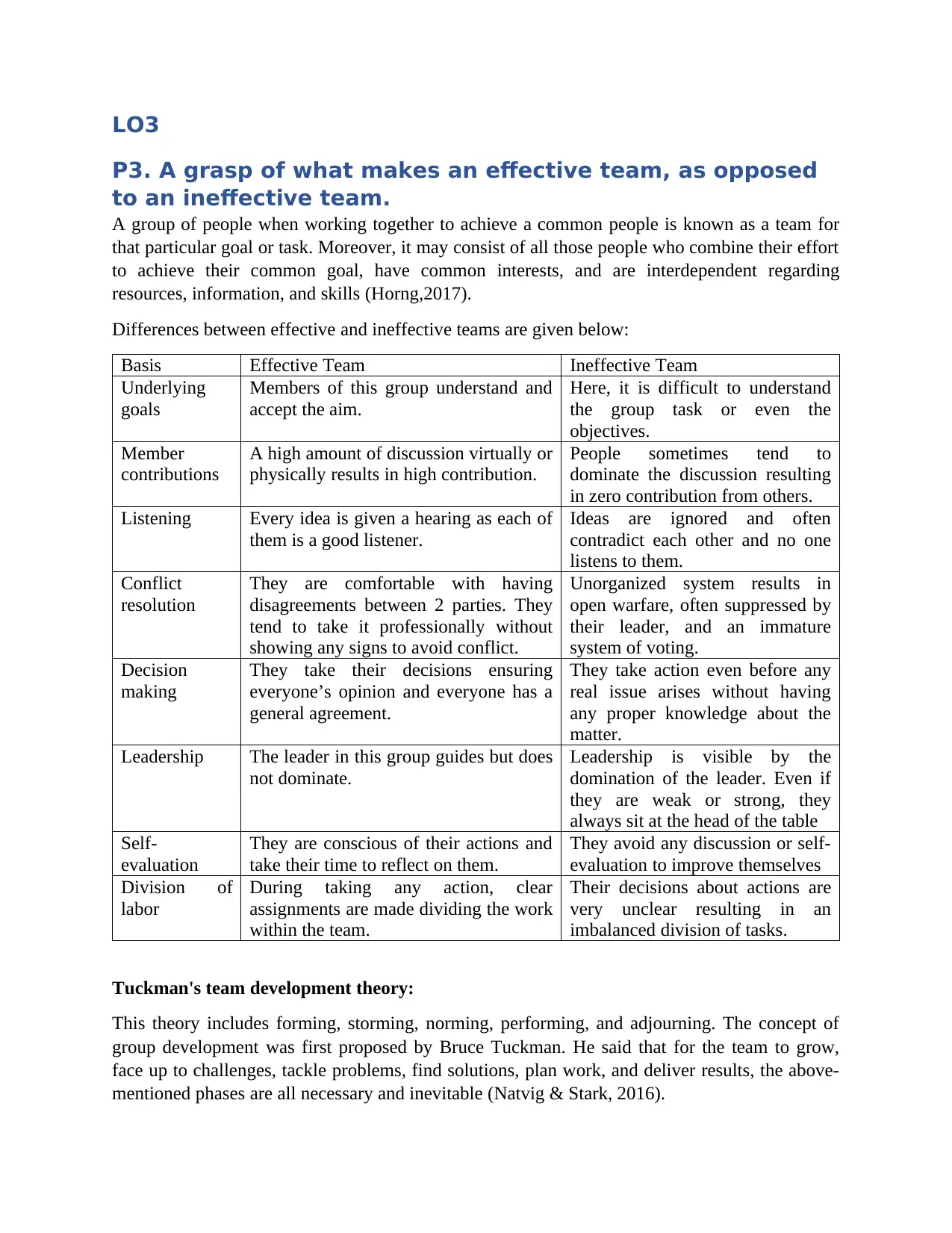
LO3
P3. A grasp of what makes an effective team, as opposed
to an ineffective team.
A group of people when working together to achieve a common people is known as a team for
that particular goal or task. Moreover, it may consist of all those people who combine their effort
to achieve their common goal, have common interests, and are interdependent regarding
resources, information, and skills (Horng,2017).
Differences between effective and ineffective teams are given below:
Basis Effective Team Ineffective Team
Underlying
goals
Members of this group understand and
accept the aim.
Here, it is difficult to understand
the group task or even the
objectives.
Member
contributions
A high amount of discussion virtually or
physically results in high contribution.
People sometimes tend to
dominate the discussion resulting
in zero contribution from others.
Listening Every idea is given a hearing as each of
them is a good listener.
Ideas are ignored and often
contradict each other and no one
listens to them.
Conflict
resolution
They are comfortable with having
disagreements between 2 parties. They
tend to take it professionally without
showing any signs to avoid conflict.
Unorganized system results in
open warfare, often suppressed by
their leader, and an immature
system of voting.
Decision
making
They take their decisions ensuring
everyone’s opinion and everyone has a
general agreement.
They take action even before any
real issue arises without having
any proper knowledge about the
matter.
Leadership The leader in this group guides but does
not dominate.
Leadership is visible by the
domination of the leader. Even if
they are weak or strong, they
always sit at the head of the table
Self-
evaluation
They are conscious of their actions and
take their time to reflect on them.
They avoid any discussion or self-
evaluation to improve themselves
Division of
labor
During taking any action, clear
assignments are made dividing the work
within the team.
Their decisions about actions are
very unclear resulting in an
imbalanced division of tasks.
Tuckman's team development theory:
This theory includes forming, storming, norming, performing, and adjourning. The concept of
group development was first proposed by Bruce Tuckman. He said that for the team to grow,
face up to challenges, tackle problems, find solutions, plan work, and deliver results, the above-
mentioned phases are all necessary and inevitable (Natvig & Stark, 2016).
P3. A grasp of what makes an effective team, as opposed
to an ineffective team.
A group of people when working together to achieve a common people is known as a team for
that particular goal or task. Moreover, it may consist of all those people who combine their effort
to achieve their common goal, have common interests, and are interdependent regarding
resources, information, and skills (Horng,2017).
Differences between effective and ineffective teams are given below:
Basis Effective Team Ineffective Team
Underlying
goals
Members of this group understand and
accept the aim.
Here, it is difficult to understand
the group task or even the
objectives.
Member
contributions
A high amount of discussion virtually or
physically results in high contribution.
People sometimes tend to
dominate the discussion resulting
in zero contribution from others.
Listening Every idea is given a hearing as each of
them is a good listener.
Ideas are ignored and often
contradict each other and no one
listens to them.
Conflict
resolution
They are comfortable with having
disagreements between 2 parties. They
tend to take it professionally without
showing any signs to avoid conflict.
Unorganized system results in
open warfare, often suppressed by
their leader, and an immature
system of voting.
Decision
making
They take their decisions ensuring
everyone’s opinion and everyone has a
general agreement.
They take action even before any
real issue arises without having
any proper knowledge about the
matter.
Leadership The leader in this group guides but does
not dominate.
Leadership is visible by the
domination of the leader. Even if
they are weak or strong, they
always sit at the head of the table
Self-
evaluation
They are conscious of their actions and
take their time to reflect on them.
They avoid any discussion or self-
evaluation to improve themselves
Division of
labor
During taking any action, clear
assignments are made dividing the work
within the team.
Their decisions about actions are
very unclear resulting in an
imbalanced division of tasks.
Tuckman's team development theory:
This theory includes forming, storming, norming, performing, and adjourning. The concept of
group development was first proposed by Bruce Tuckman. He said that for the team to grow,
face up to challenges, tackle problems, find solutions, plan work, and deliver results, the above-
mentioned phases are all necessary and inevitable (Natvig & Stark, 2016).
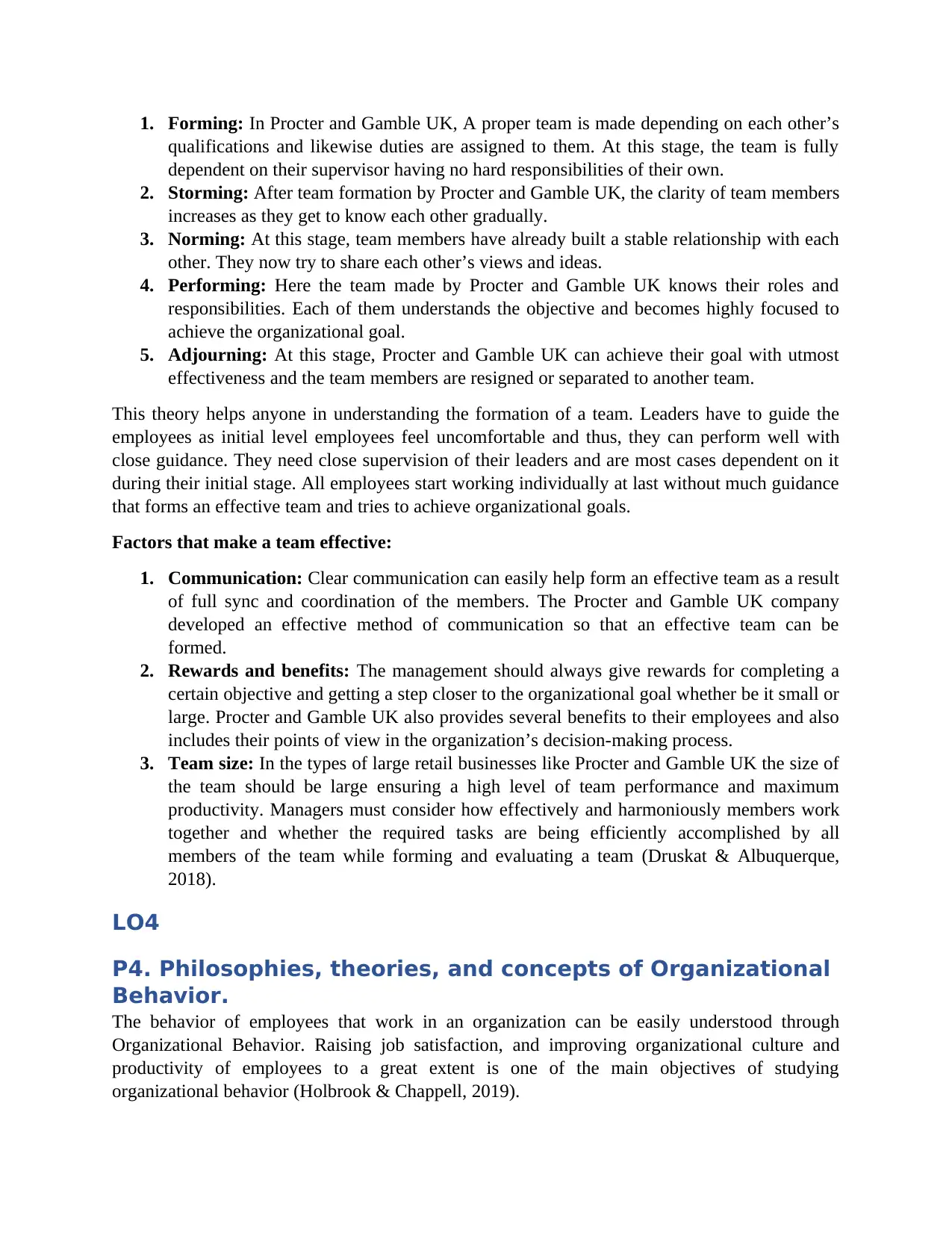
1. Forming: In Procter and Gamble UK, A proper team is made depending on each other’s
qualifications and likewise duties are assigned to them. At this stage, the team is fully
dependent on their supervisor having no hard responsibilities of their own.
2. Storming: After team formation by Procter and Gamble UK, the clarity of team members
increases as they get to know each other gradually.
3. Norming: At this stage, team members have already built a stable relationship with each
other. They now try to share each other’s views and ideas.
4. Performing: Here the team made by Procter and Gamble UK knows their roles and
responsibilities. Each of them understands the objective and becomes highly focused to
achieve the organizational goal.
5. Adjourning: At this stage, Procter and Gamble UK can achieve their goal with utmost
effectiveness and the team members are resigned or separated to another team.
This theory helps anyone in understanding the formation of a team. Leaders have to guide the
employees as initial level employees feel uncomfortable and thus, they can perform well with
close guidance. They need close supervision of their leaders and are most cases dependent on it
during their initial stage. All employees start working individually at last without much guidance
that forms an effective team and tries to achieve organizational goals.
Factors that make a team effective:
1. Communication: Clear communication can easily help form an effective team as a result
of full sync and coordination of the members. The Procter and Gamble UK company
developed an effective method of communication so that an effective team can be
formed.
2. Rewards and benefits: The management should always give rewards for completing a
certain objective and getting a step closer to the organizational goal whether be it small or
large. Procter and Gamble UK also provides several benefits to their employees and also
includes their points of view in the organization’s decision-making process.
3. Team size: In the types of large retail businesses like Procter and Gamble UK the size of
the team should be large ensuring a high level of team performance and maximum
productivity. Managers must consider how effectively and harmoniously members work
together and whether the required tasks are being efficiently accomplished by all
members of the team while forming and evaluating a team (Druskat & Albuquerque,
2018).
LO4
P4. Philosophies, theories, and concepts of Organizational
Behavior.
The behavior of employees that work in an organization can be easily understood through
Organizational Behavior. Raising job satisfaction, and improving organizational culture and
productivity of employees to a great extent is one of the main objectives of studying
organizational behavior (Holbrook & Chappell, 2019).
qualifications and likewise duties are assigned to them. At this stage, the team is fully
dependent on their supervisor having no hard responsibilities of their own.
2. Storming: After team formation by Procter and Gamble UK, the clarity of team members
increases as they get to know each other gradually.
3. Norming: At this stage, team members have already built a stable relationship with each
other. They now try to share each other’s views and ideas.
4. Performing: Here the team made by Procter and Gamble UK knows their roles and
responsibilities. Each of them understands the objective and becomes highly focused to
achieve the organizational goal.
5. Adjourning: At this stage, Procter and Gamble UK can achieve their goal with utmost
effectiveness and the team members are resigned or separated to another team.
This theory helps anyone in understanding the formation of a team. Leaders have to guide the
employees as initial level employees feel uncomfortable and thus, they can perform well with
close guidance. They need close supervision of their leaders and are most cases dependent on it
during their initial stage. All employees start working individually at last without much guidance
that forms an effective team and tries to achieve organizational goals.
Factors that make a team effective:
1. Communication: Clear communication can easily help form an effective team as a result
of full sync and coordination of the members. The Procter and Gamble UK company
developed an effective method of communication so that an effective team can be
formed.
2. Rewards and benefits: The management should always give rewards for completing a
certain objective and getting a step closer to the organizational goal whether be it small or
large. Procter and Gamble UK also provides several benefits to their employees and also
includes their points of view in the organization’s decision-making process.
3. Team size: In the types of large retail businesses like Procter and Gamble UK the size of
the team should be large ensuring a high level of team performance and maximum
productivity. Managers must consider how effectively and harmoniously members work
together and whether the required tasks are being efficiently accomplished by all
members of the team while forming and evaluating a team (Druskat & Albuquerque,
2018).
LO4
P4. Philosophies, theories, and concepts of Organizational
Behavior.
The behavior of employees that work in an organization can be easily understood through
Organizational Behavior. Raising job satisfaction, and improving organizational culture and
productivity of employees to a great extent is one of the main objectives of studying
organizational behavior (Holbrook & Chappell, 2019).
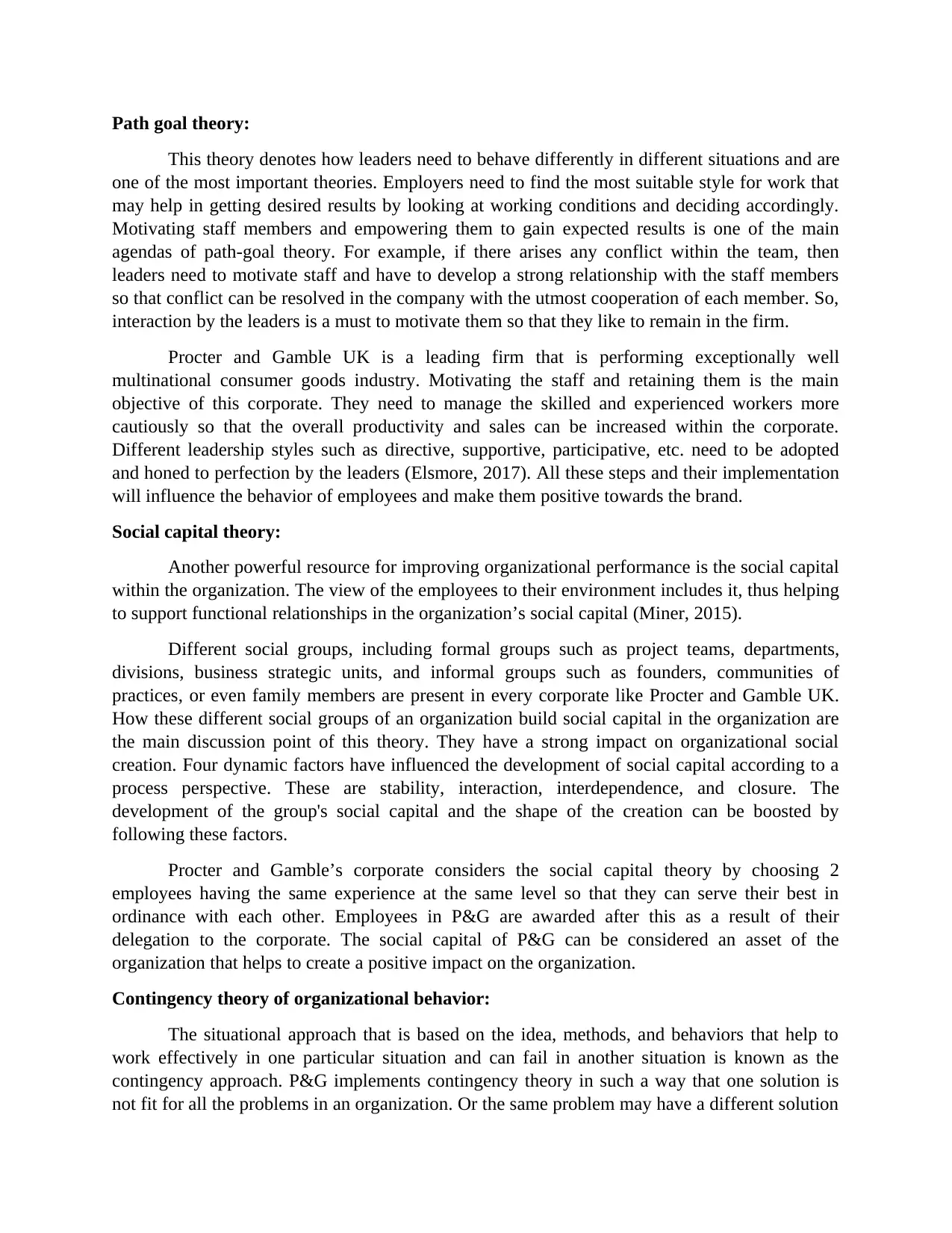
Path goal theory:
This theory denotes how leaders need to behave differently in different situations and are
one of the most important theories. Employers need to find the most suitable style for work that
may help in getting desired results by looking at working conditions and deciding accordingly.
Motivating staff members and empowering them to gain expected results is one of the main
agendas of path-goal theory. For example, if there arises any conflict within the team, then
leaders need to motivate staff and have to develop a strong relationship with the staff members
so that conflict can be resolved in the company with the utmost cooperation of each member. So,
interaction by the leaders is a must to motivate them so that they like to remain in the firm.
Procter and Gamble UK is a leading firm that is performing exceptionally well
multinational consumer goods industry. Motivating the staff and retaining them is the main
objective of this corporate. They need to manage the skilled and experienced workers more
cautiously so that the overall productivity and sales can be increased within the corporate.
Different leadership styles such as directive, supportive, participative, etc. need to be adopted
and honed to perfection by the leaders (Elsmore, 2017). All these steps and their implementation
will influence the behavior of employees and make them positive towards the brand.
Social capital theory:
Another powerful resource for improving organizational performance is the social capital
within the organization. The view of the employees to their environment includes it, thus helping
to support functional relationships in the organization’s social capital (Miner, 2015).
Different social groups, including formal groups such as project teams, departments,
divisions, business strategic units, and informal groups such as founders, communities of
practices, or even family members are present in every corporate like Procter and Gamble UK.
How these different social groups of an organization build social capital in the organization are
the main discussion point of this theory. They have a strong impact on organizational social
creation. Four dynamic factors have influenced the development of social capital according to a
process perspective. These are stability, interaction, interdependence, and closure. The
development of the group's social capital and the shape of the creation can be boosted by
following these factors.
Procter and Gamble’s corporate considers the social capital theory by choosing 2
employees having the same experience at the same level so that they can serve their best in
ordinance with each other. Employees in P&G are awarded after this as a result of their
delegation to the corporate. The social capital of P&G can be considered an asset of the
organization that helps to create a positive impact on the organization.
Contingency theory of organizational behavior:
The situational approach that is based on the idea, methods, and behaviors that help to
work effectively in one particular situation and can fail in another situation is known as the
contingency approach. P&G implements contingency theory in such a way that one solution is
not fit for all the problems in an organization. Or the same problem may have a different solution
This theory denotes how leaders need to behave differently in different situations and are
one of the most important theories. Employers need to find the most suitable style for work that
may help in getting desired results by looking at working conditions and deciding accordingly.
Motivating staff members and empowering them to gain expected results is one of the main
agendas of path-goal theory. For example, if there arises any conflict within the team, then
leaders need to motivate staff and have to develop a strong relationship with the staff members
so that conflict can be resolved in the company with the utmost cooperation of each member. So,
interaction by the leaders is a must to motivate them so that they like to remain in the firm.
Procter and Gamble UK is a leading firm that is performing exceptionally well
multinational consumer goods industry. Motivating the staff and retaining them is the main
objective of this corporate. They need to manage the skilled and experienced workers more
cautiously so that the overall productivity and sales can be increased within the corporate.
Different leadership styles such as directive, supportive, participative, etc. need to be adopted
and honed to perfection by the leaders (Elsmore, 2017). All these steps and their implementation
will influence the behavior of employees and make them positive towards the brand.
Social capital theory:
Another powerful resource for improving organizational performance is the social capital
within the organization. The view of the employees to their environment includes it, thus helping
to support functional relationships in the organization’s social capital (Miner, 2015).
Different social groups, including formal groups such as project teams, departments,
divisions, business strategic units, and informal groups such as founders, communities of
practices, or even family members are present in every corporate like Procter and Gamble UK.
How these different social groups of an organization build social capital in the organization are
the main discussion point of this theory. They have a strong impact on organizational social
creation. Four dynamic factors have influenced the development of social capital according to a
process perspective. These are stability, interaction, interdependence, and closure. The
development of the group's social capital and the shape of the creation can be boosted by
following these factors.
Procter and Gamble’s corporate considers the social capital theory by choosing 2
employees having the same experience at the same level so that they can serve their best in
ordinance with each other. Employees in P&G are awarded after this as a result of their
delegation to the corporate. The social capital of P&G can be considered an asset of the
organization that helps to create a positive impact on the organization.
Contingency theory of organizational behavior:
The situational approach that is based on the idea, methods, and behaviors that help to
work effectively in one particular situation and can fail in another situation is known as the
contingency approach. P&G implements contingency theory in such a way that one solution is
not fit for all the problems in an organization. Or the same problem may have a different solution
Secure Best Marks with AI Grader
Need help grading? Try our AI Grader for instant feedback on your assignments.
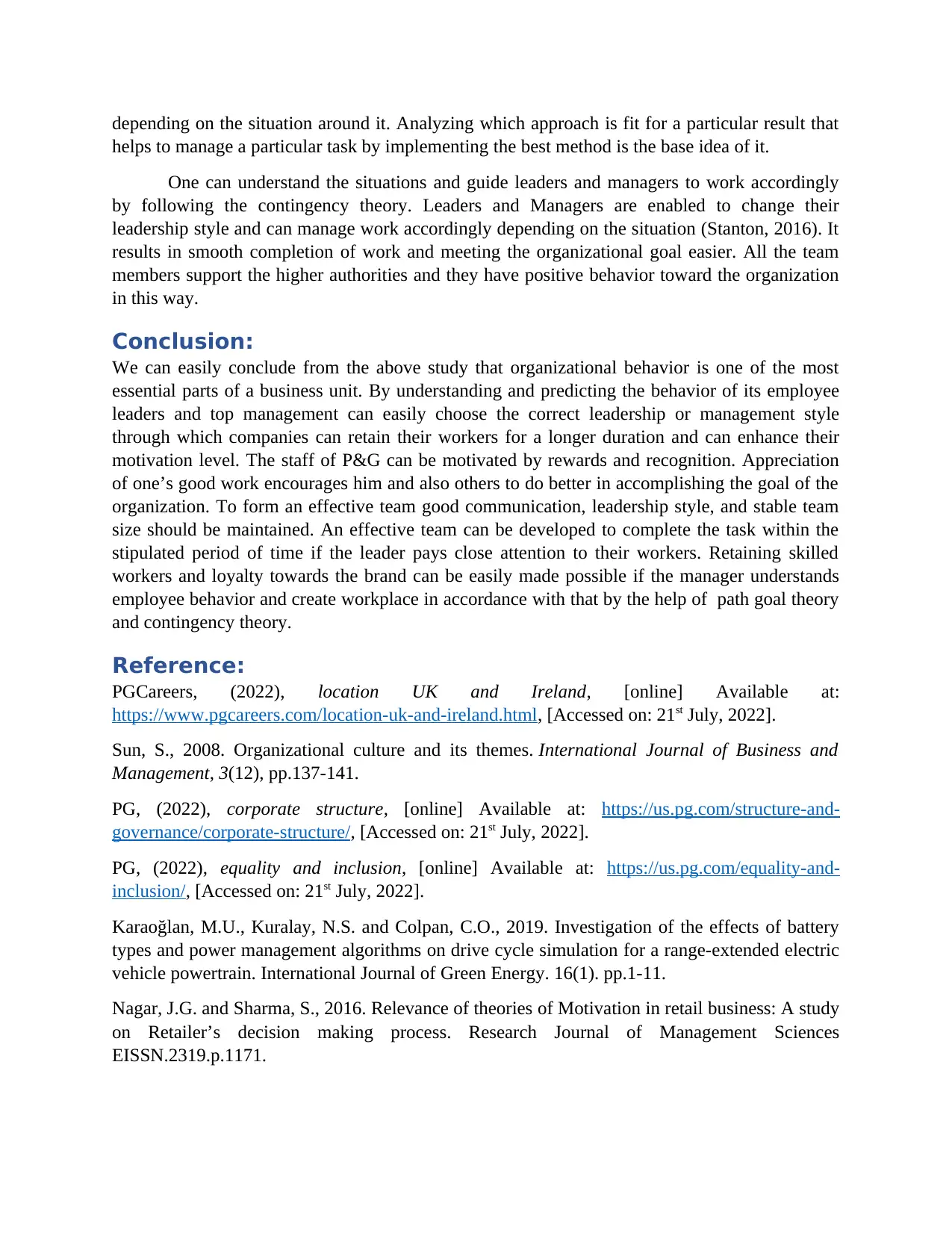
depending on the situation around it. Analyzing which approach is fit for a particular result that
helps to manage a particular task by implementing the best method is the base idea of it.
One can understand the situations and guide leaders and managers to work accordingly
by following the contingency theory. Leaders and Managers are enabled to change their
leadership style and can manage work accordingly depending on the situation (Stanton, 2016). It
results in smooth completion of work and meeting the organizational goal easier. All the team
members support the higher authorities and they have positive behavior toward the organization
in this way.
Conclusion:
We can easily conclude from the above study that organizational behavior is one of the most
essential parts of a business unit. By understanding and predicting the behavior of its employee
leaders and top management can easily choose the correct leadership or management style
through which companies can retain their workers for a longer duration and can enhance their
motivation level. The staff of P&G can be motivated by rewards and recognition. Appreciation
of one’s good work encourages him and also others to do better in accomplishing the goal of the
organization. To form an effective team good communication, leadership style, and stable team
size should be maintained. An effective team can be developed to complete the task within the
stipulated period of time if the leader pays close attention to their workers. Retaining skilled
workers and loyalty towards the brand can be easily made possible if the manager understands
employee behavior and create workplace in accordance with that by the help of path goal theory
and contingency theory.
Reference:
PGCareers, (2022), location UK and Ireland, [online] Available at:
https://www.pgcareers.com/location-uk-and-ireland.html, [Accessed on: 21st July, 2022].
Sun, S., 2008. Organizational culture and its themes. International Journal of Business and
Management, 3(12), pp.137-141.
PG, (2022), corporate structure, [online] Available at: https://us.pg.com/structure-and-
governance/corporate-structure/, [Accessed on: 21st July, 2022].
PG, (2022), equality and inclusion, [online] Available at: https://us.pg.com/equality-and-
inclusion/, [Accessed on: 21st July, 2022].
Karaoğlan, M.U., Kuralay, N.S. and Colpan, C.O., 2019. Investigation of the effects of battery
types and power management algorithms on drive cycle simulation for a range-extended electric
vehicle powertrain. International Journal of Green Energy. 16(1). pp.1-11.
Nagar, J.G. and Sharma, S., 2016. Relevance of theories of Motivation in retail business: A study
on Retailer’s decision making process. Research Journal of Management Sciences
EISSN.2319.p.1171.
helps to manage a particular task by implementing the best method is the base idea of it.
One can understand the situations and guide leaders and managers to work accordingly
by following the contingency theory. Leaders and Managers are enabled to change their
leadership style and can manage work accordingly depending on the situation (Stanton, 2016). It
results in smooth completion of work and meeting the organizational goal easier. All the team
members support the higher authorities and they have positive behavior toward the organization
in this way.
Conclusion:
We can easily conclude from the above study that organizational behavior is one of the most
essential parts of a business unit. By understanding and predicting the behavior of its employee
leaders and top management can easily choose the correct leadership or management style
through which companies can retain their workers for a longer duration and can enhance their
motivation level. The staff of P&G can be motivated by rewards and recognition. Appreciation
of one’s good work encourages him and also others to do better in accomplishing the goal of the
organization. To form an effective team good communication, leadership style, and stable team
size should be maintained. An effective team can be developed to complete the task within the
stipulated period of time if the leader pays close attention to their workers. Retaining skilled
workers and loyalty towards the brand can be easily made possible if the manager understands
employee behavior and create workplace in accordance with that by the help of path goal theory
and contingency theory.
Reference:
PGCareers, (2022), location UK and Ireland, [online] Available at:
https://www.pgcareers.com/location-uk-and-ireland.html, [Accessed on: 21st July, 2022].
Sun, S., 2008. Organizational culture and its themes. International Journal of Business and
Management, 3(12), pp.137-141.
PG, (2022), corporate structure, [online] Available at: https://us.pg.com/structure-and-
governance/corporate-structure/, [Accessed on: 21st July, 2022].
PG, (2022), equality and inclusion, [online] Available at: https://us.pg.com/equality-and-
inclusion/, [Accessed on: 21st July, 2022].
Karaoğlan, M.U., Kuralay, N.S. and Colpan, C.O., 2019. Investigation of the effects of battery
types and power management algorithms on drive cycle simulation for a range-extended electric
vehicle powertrain. International Journal of Green Energy. 16(1). pp.1-11.
Nagar, J.G. and Sharma, S., 2016. Relevance of theories of Motivation in retail business: A study
on Retailer’s decision making process. Research Journal of Management Sciences
EISSN.2319.p.1171.
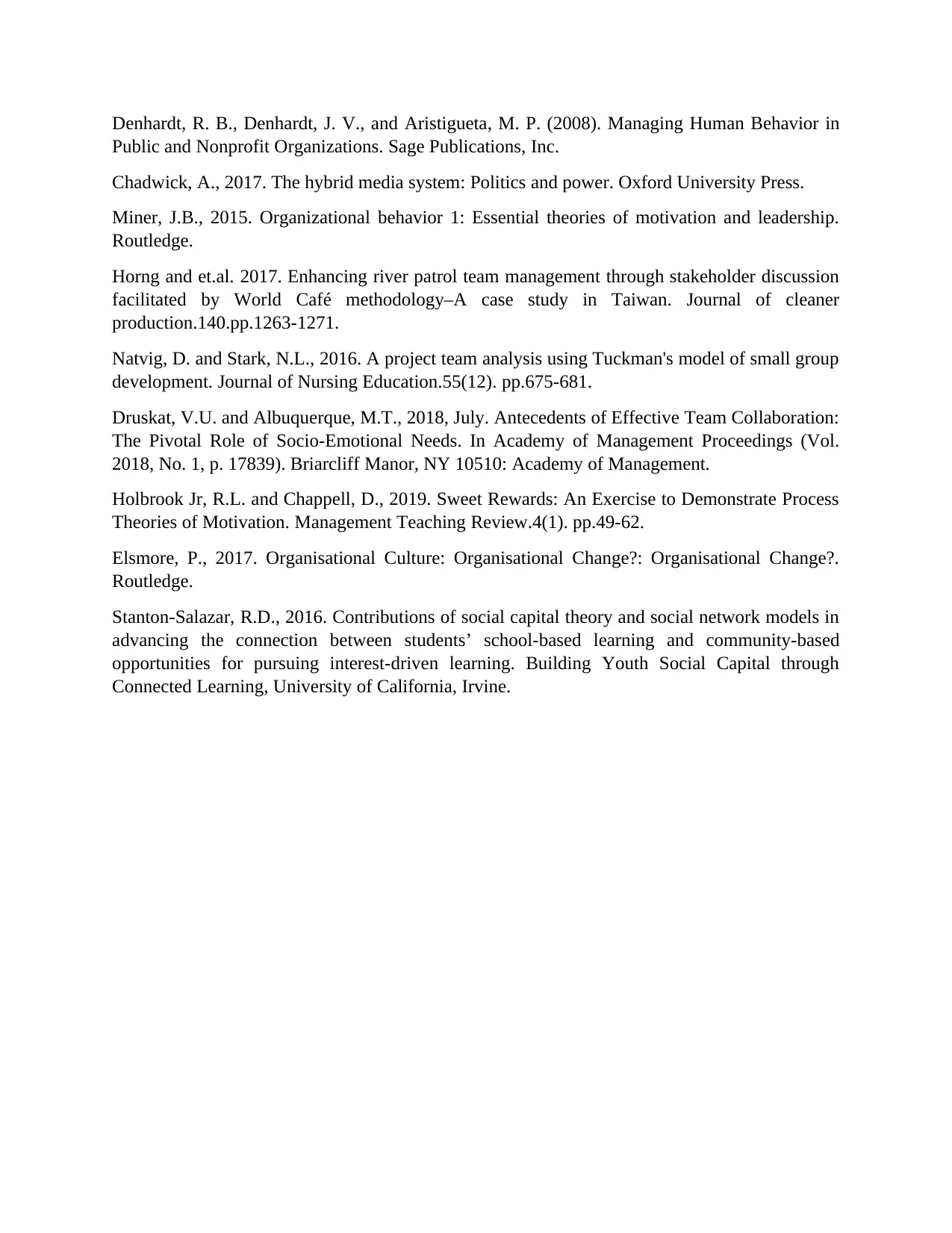
Denhardt, R. B., Denhardt, J. V., and Aristigueta, M. P. (2008). Managing Human Behavior in
Public and Nonprofit Organizations. Sage Publications, Inc.
Chadwick, A., 2017. The hybrid media system: Politics and power. Oxford University Press.
Miner, J.B., 2015. Organizational behavior 1: Essential theories of motivation and leadership.
Routledge.
Horng and et.al. 2017. Enhancing river patrol team management through stakeholder discussion
facilitated by World Café methodology–A case study in Taiwan. Journal of cleaner
production.140.pp.1263-1271.
Natvig, D. and Stark, N.L., 2016. A project team analysis using Tuckman's model of small group
development. Journal of Nursing Education.55(12). pp.675-681.
Druskat, V.U. and Albuquerque, M.T., 2018, July. Antecedents of Effective Team Collaboration:
The Pivotal Role of Socio-Emotional Needs. In Academy of Management Proceedings (Vol.
2018, No. 1, p. 17839). Briarcliff Manor, NY 10510: Academy of Management.
Holbrook Jr, R.L. and Chappell, D., 2019. Sweet Rewards: An Exercise to Demonstrate Process
Theories of Motivation. Management Teaching Review.4(1). pp.49-62.
Elsmore, P., 2017. Organisational Culture: Organisational Change?: Organisational Change?.
Routledge.
Stanton-Salazar, R.D., 2016. Contributions of social capital theory and social network models in
advancing the connection between students’ school-based learning and community-based
opportunities for pursuing interest-driven learning. Building Youth Social Capital through
Connected Learning, University of California, Irvine.
Public and Nonprofit Organizations. Sage Publications, Inc.
Chadwick, A., 2017. The hybrid media system: Politics and power. Oxford University Press.
Miner, J.B., 2015. Organizational behavior 1: Essential theories of motivation and leadership.
Routledge.
Horng and et.al. 2017. Enhancing river patrol team management through stakeholder discussion
facilitated by World Café methodology–A case study in Taiwan. Journal of cleaner
production.140.pp.1263-1271.
Natvig, D. and Stark, N.L., 2016. A project team analysis using Tuckman's model of small group
development. Journal of Nursing Education.55(12). pp.675-681.
Druskat, V.U. and Albuquerque, M.T., 2018, July. Antecedents of Effective Team Collaboration:
The Pivotal Role of Socio-Emotional Needs. In Academy of Management Proceedings (Vol.
2018, No. 1, p. 17839). Briarcliff Manor, NY 10510: Academy of Management.
Holbrook Jr, R.L. and Chappell, D., 2019. Sweet Rewards: An Exercise to Demonstrate Process
Theories of Motivation. Management Teaching Review.4(1). pp.49-62.
Elsmore, P., 2017. Organisational Culture: Organisational Change?: Organisational Change?.
Routledge.
Stanton-Salazar, R.D., 2016. Contributions of social capital theory and social network models in
advancing the connection between students’ school-based learning and community-based
opportunities for pursuing interest-driven learning. Building Youth Social Capital through
Connected Learning, University of California, Irvine.
1 out of 12
Related Documents
Your All-in-One AI-Powered Toolkit for Academic Success.
+13062052269
info@desklib.com
Available 24*7 on WhatsApp / Email
![[object Object]](/_next/static/media/star-bottom.7253800d.svg)
Unlock your academic potential
© 2024 | Zucol Services PVT LTD | All rights reserved.





